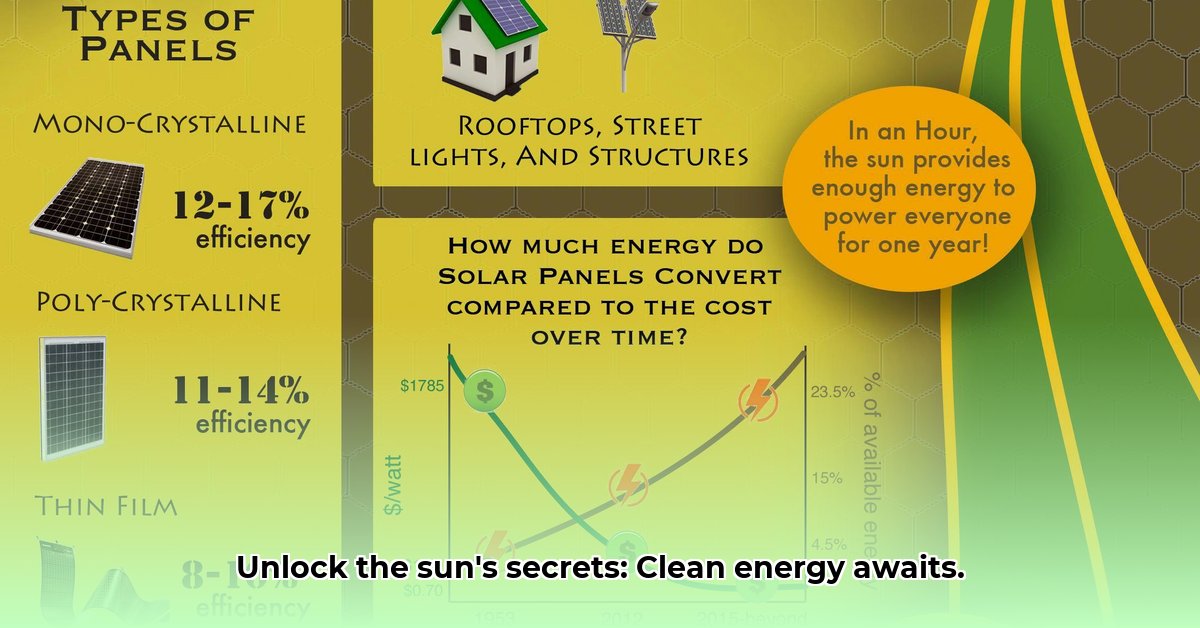Ever wonder about the sun’s power beyond just warmth? It’s far more amazing than you think! Solar energy isn’t just about saving the planet; it’s packed with cool technology and surprising facts. From clever ways to make solar panels super-efficient to figuring out which type is right for your home, we’ll explore it all. We’ll unravel why solar is so important for a greener future, explore what others are doing around the globe, and even reveal some mind-blowing facts that’ll change how you view solar power. Get ready to be surprised – and maybe even inspired to harness the sun’s energy yourself! For more fun facts, check out these solar energy fun facts.
Interesting Facts About Solar Energy: Renewable Energy Sources
Let’s shine a light on solar energy – it’s more exciting than you might think! This clean energy source is booming, and it’s changing the world, one sunbeam at a time. Solar power costs have significantly decreased. But it’s still only scratching the surface of its potential.
Harnessing Solar Power: A Bright and Sustainable Future
In the last decade, solar power costs have dropped by 80%! That’s a game-changer. Solar energy is now a serious competitor to fossil fuels, and smart inventions and government initiatives are accelerating its growth. This massive shift toward clean energy is nothing short of amazing. This cost reduction is largely attributed to advancements in manufacturing processes, increased material efficiency, and economies of scale. Continuous innovation in solar technologies is further expected to drive down costs.
Solar Growth and Clean Energy Capacity
The world’s solar power capacity has more than doubled since 2015! That means there will be over 1000 gigawatts of clean energy by 2024. Solar energy is effective and promising. This growth reflects increasing global awareness of environmental issues, coupled with supportive government policies that incentivize solar installations. Countries worldwide are recognizing the long-term economic and environmental benefits of solar energy.
- Solar power costs have decreased by 80% since 2008.
- Global solar power capacity has more than doubled since 2015.
- Expect over 1000 gigawatts of clean energy by 2024.
Diverse Solar Energy Technologies: Beyond Traditional Panels
Solar energy isn’t just limited to rooftop panels. Photovoltaic (PV) systems directly convert sunlight into electricity. Concentrated solar power (CSP) uses mirrors to focus sunlight and create heat to generate electricity. Scientists are exploring space-based solar power (SSP), which would involve placing solar collectors in space to beam energy back to Earth. Each approach presents unique benefits and challenges.
Environmental Benefits: Cleaner Planet with Solar Energy
The environmental benefits of solar energy are substantial. It dramatically reduces greenhouse gas emissions compared to fossil fuels, contributing to a healthier planet and mitigating climate change. Widespread adoption of solar energy can significantly improve air and water quality, reduce reliance on finite resources, and minimize habitat disruption associated with fossil fuel extraction.
Challenges and Innovations in Sustainable Energy Storage
Large solar farms require significant land areas. Energy storage solutions are needed to ensure a continuous power supply even when the sun isn’t shining. Integrating new solar power sources into existing power grids poses logistical and technical challenges. Scientists and engineers are focused on addressing the challenges. Research and development efforts are centered on advanced battery technologies, pumped hydro storage, and thermal energy storage systems.
Promising Future: Technological Advancements in Solar Power
The future of solar is full of potential. New technologies, such as perovskite solar cells, could drastically improve the efficiency of converting sunlight into energy. Battery technology is also advancing, enabling more effective storage of solar power. Continuous innovation in materials science, energy storage, and smart grid technologies is expected to further enhance solar energy’s efficiency, reliability, and affordability.
Global Solar Adoption and International Collaboration
Adoption rates for solar energy vary due to political and economic factors. However, there’s a growing global commitment to renewable energy sources. International collaboration is essential for realizing solar energy’s full potential worldwide. Sharing knowledge, resources, and best practices can accelerate solar deployment and address common challenges. Numerous international agreements and initiatives aim to facilitate the transition to a sustainable energy future.
Interesting Facts About Solar Energy: A Concise Summary
Here’s a quick recap of key aspects of solar energy:
| Feature | Details |
|---|---|
| Cost | Has significantly decreased since 2008 due to technological advancements and increased production scale |
| Global Growth | Has more than doubled since 2015, projected to exceed 1000 GW by 2024 with increasing global installations |
| Environmental Impact | Significantly reduces greenhouse gas emissions compared to fossil fuels, aiding in the fight against climate change |
| Types of Solar Technology | Includes Photovoltaic (PV), Concentrated Solar Power (CSP), and the potential for Space-Based Solar Power (SSP) |
| Challenges | Land requirements, energy storage limitations, grid integration complexities |
| Future Outlook | Very promising due to continuous advancements, supportive policies, and growing global awareness |
Solar energy represents a compelling combination of innovation, environmental stewardship, and a pathway to a brighter, more sustainable future powered by the sun.
Mitigating Risks in Space-Based Solar Power Development for Sustainable Global Energy
Imagine a future powered by clean energy beamed from satellites orbiting Earth. That’s the vision of space-based solar power (SBSP). Achieving this vision requires careful planning and risk mitigation.
Navigating Legal Frameworks for Space Solar Projects
The Outer Space Treaty of 1967 prohibits national appropriation of celestial bodies, posing legal challenges for space-based solar power. International collaboration is essential for establishing clear guidelines on resource utilization and orbital debris management. Diplomatic efforts and a commitment to responsible space exploration are crucial for addressing legal complexities.
International collaboration is key to overcoming legal and ethical hurdles.
Addressing Space Debris
Launching and maintaining SBSP infrastructure contributes to the growing problem of space debris and collisions with defunct satellites. Proactive solutions are needed, including advanced tracking systems and debris removal technologies. Careful planning of satellite orbits and use of durable components are essential for mitigating these risks.
- The Outer Space Treaty of 1967 restricts national appropriation of celestial bodies.
- Advanced tracking systems and debris removal technologies are essential for mitigating risks.
- International cooperation is crucial for addressing legal, environmental, and economic hurdles.
Economic factors
SBSP requires a substantial initial investment. Demonstrating its cost-effectiveness compared to terrestrial renewable energy sources is essential for securing public and private investment. Ongoing research and development, technological innovation, and strategic financial planning are critical for ensuring its economic viability.
Importance of International Cooperation for Renewable Energy
SBSP demands robust international partnerships for sharing resources, expertise, and technological advancements. Strong diplomatic relations and equitable benefit-sharing are crucial for long-term success.
Technological Hurdles and Mitigation Strategies for Sustainability
Efficient energy transmission from space to Earth and the development of durable, lightweight solar panels are key technological challenges. Continuous innovation, robust testing, and diversified technology approaches are essential for mitigating the risks and ensuring the feasibility of SBSP.
Ongoing advancements in materials are crucial for space solar panels.
Solar Panel Types: Choosing the Best Solution for Smart Energy
Choosing the right solar panels can seem complicated. Understanding monocrystalline, polycrystalline, and thin-film options can help simplify the decision.
Monocrystalline Panels: The Efficiency Champions for Sustainable Energy
Monocrystalline panels are made from a single silicon crystal, giving them a dark, uniform appearance. Known for their high energy conversion efficiency, they are a top choice for maximizing energy production.
Their high cost should be taken into account when buying.
Polycrystalline Panels: Reliable and Affordable Solar Solutions
Polycrystalline panels are made from multiple silicon crystals. This makes the manufacturing cheaper, resulting in lower upfront costs. While
- Hydro Extrusions USA Leads North American Aluminum Profile Solutions - December 28, 2025
- Hydro North America Leads Aluminum Extrusion Solutions Across Diverse Industries - December 27, 2025
- Hydro Extrusion North America Provides Custom Solutions Across Diverse - December 26, 2025
















